Reproduction and Lifecycle
Reproduction:
The Paralithodes camtschatica are dioecious, meaning separate sexes, and have external fertilization.1 External fertilization is possible for this species because they are aquatic and able to transfer sperm outside the body, without risk of the sperm to dry out. Also, the females are polygynous, only mating once a year.2
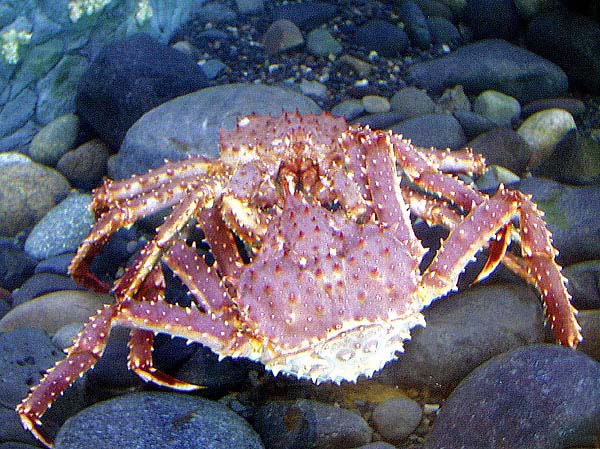 The reproduction cycle of the red king crab begins with the females attracting
the males by pheromones after their eggs are hatched. Once the male finds the
female, he then attaches to her, grasping her by the claws into a face-to-face
position. They stay connected until the female molts her carapace and creates
new eggs. Once the female is in her soft-shell state, mating can then occur.3 The male then spreads his spermatophores over the females pleopods by
his fifth pair of legs, the eggs being released immediately after mating. The
female can also store the sperm if the eggs are not ready to be released yet.
The reproduction cycle of the red king crab begins with the females attracting
the males by pheromones after their eggs are hatched. Once the male finds the
female, he then attaches to her, grasping her by the claws into a face-to-face
position. They stay connected until the female molts her carapace and creates
new eggs. Once the female is in her soft-shell state, mating can then occur.3 The male then spreads his spermatophores over the females pleopods by
his fifth pair of legs, the eggs being released immediately after mating. The
female can also store the sperm if the eggs are not ready to be released yet.
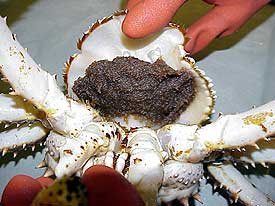 Once the eggs are released, they are fertilized when passing over the
spermatophores, then held in a spongy mass between her abdominal flap and body,
on her pleopods.4 An average clutch size for the female crab is
between 150000-400000 eggs.5 Here they stay attached for about a
year, the female keeping them healthy, by “waving” water over them, and
protected, sheltered from predators.6 Then once the eggs are
hatched, the cycle begins again.
Once the eggs are released, they are fertilized when passing over the
spermatophores, then held in a spongy mass between her abdominal flap and body,
on her pleopods.4 An average clutch size for the female crab is
between 150000-400000 eggs.5 Here they stay attached for about a
year, the female keeping them healthy, by “waving” water over them, and
protected, sheltered from predators.6 Then once the eggs are
hatched, the cycle begins again.
Lifecycle:
The lifecycle of the Paralithodes camtschatica has three main stages of development: 1. Zoea, 2. Megalops, 3. the Adult decapod.
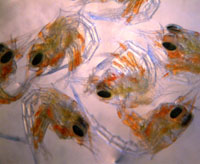 The life of a red king crab begins inside the egg, where 2 stages of larval
development occur.1 Then, the eggs hatch into the newborn king crab, called zoea,
and act as free swimming organisms, carried along by the ocean currents. The
zoea does not resemble the adult decapod, differing from the true crab form by
having a tail, or telson, and also having feathered limbs instead of clawed
limbs.2 This all changes as it undergoes metamorphosis, having 4 developmental
stages during the first two to four months, molting up to five times, each time
increasing its size, form, and functions.3 The zoea are adapted for swimming,
yet do not have much power against the ocean currents, thus being swept away
from the “parental grounds” to an unknown destination, in hopes they end up in a
good habitat, full of food and away from much predation.4
The life of a red king crab begins inside the egg, where 2 stages of larval
development occur.1 Then, the eggs hatch into the newborn king crab, called zoea,
and act as free swimming organisms, carried along by the ocean currents. The
zoea does not resemble the adult decapod, differing from the true crab form by
having a tail, or telson, and also having feathered limbs instead of clawed
limbs.2 This all changes as it undergoes metamorphosis, having 4 developmental
stages during the first two to four months, molting up to five times, each time
increasing its size, form, and functions.3 The zoea are adapted for swimming,
yet do not have much power against the ocean currents, thus being swept away
from the “parental grounds” to an unknown destination, in hopes they end up in a
good habitat, full of food and away from much predation.4
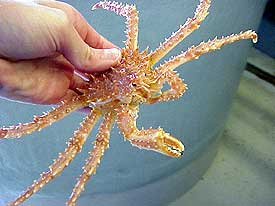 The next stage of the red king crab is the megalops stage, where the feathered
limbs are now clawed limbs and the juvenile crab now more closely resembles the
adult. Still the abdomen is prominent and the crab is about an eighth of an
inch. Megalops develop a benthic, or bottom dwelling lifecycle5 and also develop
a special colonial characteristic called podding, when around the age of
2. In podding, the juvenile crab
The next stage of the red king crab is the megalops stage, where the feathered
limbs are now clawed limbs and the juvenile crab now more closely resembles the
adult. Still the abdomen is prominent and the crab is about an eighth of an
inch. Megalops develop a benthic, or bottom dwelling lifecycle5 and also develop
a special colonial characteristic called podding, when around the age of
2. In podding, the juvenile crab form large groups of individuals at shallow depths, used for protection. This is good system for protection because the megalops are still vulnerable.6 Because they are not highly armored like the
adult, staying in these massive groups makes the predator have to find them and
also saves many from predation because the predator can only eat so many.7
Also these big groups help during the molting season, the time the crab is most
susceptible to predation.8 The megalops stage can last up to 4 years and then the
crab passes onto adulthood.
form large groups of individuals at shallow depths, used for protection. This is good system for protection because the megalops are still vulnerable.6 Because they are not highly armored like the
adult, staying in these massive groups makes the predator have to find them and
also saves many from predation because the predator can only eat so many.7
Also these big groups help during the molting season, the time the crab is most
susceptible to predation.8 The megalops stage can last up to 4 years and then the
crab passes onto adulthood.
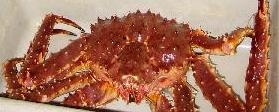 Adult red king crabs now migrate to the depths
of the ocean, to depths of about 200 meters or below. The adult is heavily
armored with a hard calcified carapace and have sharp spines extending from the
shell. (9.3) The adult decapod has few predators, it is free to roam the ocean
floor. Interesting fact of the adults is that they are segregated by sex when
in their deep environment, and only do they then come together for the mating
season in the spring. (9.2) The adult keeps growing and growing, molting every
time, their main limit now on life being over-fishing.9
Adult red king crabs now migrate to the depths
of the ocean, to depths of about 200 meters or below. The adult is heavily
armored with a hard calcified carapace and have sharp spines extending from the
shell. (9.3) The adult decapod has few predators, it is free to roam the ocean
floor. Interesting fact of the adults is that they are segregated by sex when
in their deep environment, and only do they then come together for the mating
season in the spring. (9.2) The adult keeps growing and growing, molting every
time, their main limit now on life being over-fishing.9